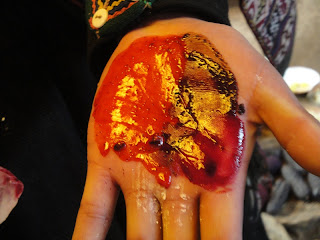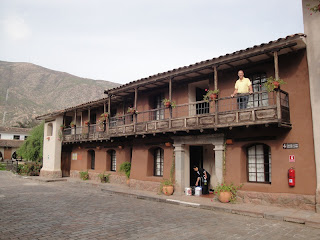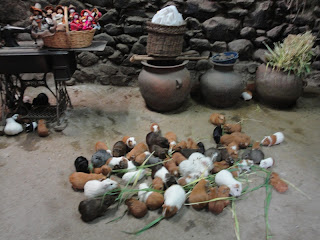Wake-up call at 6:30 am because departure for a full-day exploration of the Sacred Valley is at 8:00 am. This is a beautiful and historic region with agricultural terraces sculpted from the mountainsides.
In front of our room.
Breakfast. Look at that ancient stove from France.
Lock and huge key to our room.
The view from our room.
We are in the bus and on our way. Photo taken while driving.
Photo opportunity stop.
The Sacred Valley.
We stop to visit the farming village of Chincheros, where natives live much as their ancestors did.
This is the street of the spinners and weavers.
All over Peru every house seems to have these oxen on top of it. Each one seems to incorporate different things though. I think they are asking for a blessing.
This weaver community gives us a demonstration about the natural dies they use. It is extremely interesting, very well done and even humorous. Unfortunately I can't recall all the names of the plants etc. But each one also seems to also have a medicinal purpose. We are offered a hot wild mint drink which is very nice.
The ladies in there traditional costumes. We are told that Peruvian ladies hats are distinctive to each area.
Babies are carried on the backs in a sling.
After being shown different wools from llamas or alpacas and how dirty they are because these animals don't shower, the leader shows us that they use a root as soap. She grates some of it into a bowl.
It makes bubbles easily and the wool comes out like snow. It also has a nice smell.
The red die comes from the cochineal, a scale insect living on the prickly pear cactus.
If you want to know more about it click here.

The leader just scraped a few off the cactus and squashed them in her palm.
They also use it as lipstick.
Then she explains the weaving process.
Since we like what we see and the quality, we make a purchase.

Right outside the weavers are other vendors. This lady is selling crochet finger puppets as many do in all the areas we are visiting. She has made them herself. I buy a condor.
From there we walk to see some old Inca ruins.
Of course the Spanish have reached this place and built on top of it.
This is the church. No pictures allowed inside. All the walls and the ceiling are painted with pictures and statues of saints in masses. I can't say that it was pretty.
Trying to capture the moment from the bus window. I think the shepherd(ess) was washing in the stream.
We stop to see the circular terraces of Moray. Large, natural depressions in the landscape that the Inca sculpted into terraces hundreds of years ago to serve as an experimental station for the development of different strains of crops.
The saltpans in the colonial village of Maras, developed by the Inca and still in use today.
We have lunch at a restaurant in a hotel quite remote. It has a lovely garden with roses. We are outside under umbrellas. The food was very nice but the chairs were the most uncomfortable ones I have EVER sat on.
After lunch we tour the massive ruins at Ollantaytambo, both a temple and a fortress, where work mysteriously halted centuries ago.
The streets are laid out in a very orderly fashion and very sophisticated with drainage etc.
Fernando takes us into one household to show us how the people live today.
Guinea pigs running around in the kitchens/living places in many families. Just like chickens and dogs seem to run around loose. A boy was feeding these.
There were other items hanging on the walls and on display. Some I found quite gloomy and macabre like sculls of ancestors and didn't feel like taking a picture.
A market in front of the ruins' entrance.
The mountain opposite with carvings and storehouses built.
A close-up of the above. Can you see the face?
We climb up the ruins. MANY uneven steps. I huff and puff but am so happy I did it. Fernando points out the incredible Inca work. They had no iron tools, no wheels for transportation, but still there is amazing workmanship. The stones fit perfectly. This is granite just chiseled with harder stones. No mortar in-between these. Most of the stones are huge, many weighing several tons.
On the top the huge pink granite stones of the temple, transported from a quarry across the valley.
You have to be impressed.
The view from the top.
Dinner is in the restaurant of our hotel. This time I have the Andean trout. Very nice.

























































1 comment:
Wow! Christa, what a wonderful travelogue you're giving us. I love it!
Adele
Post a Comment